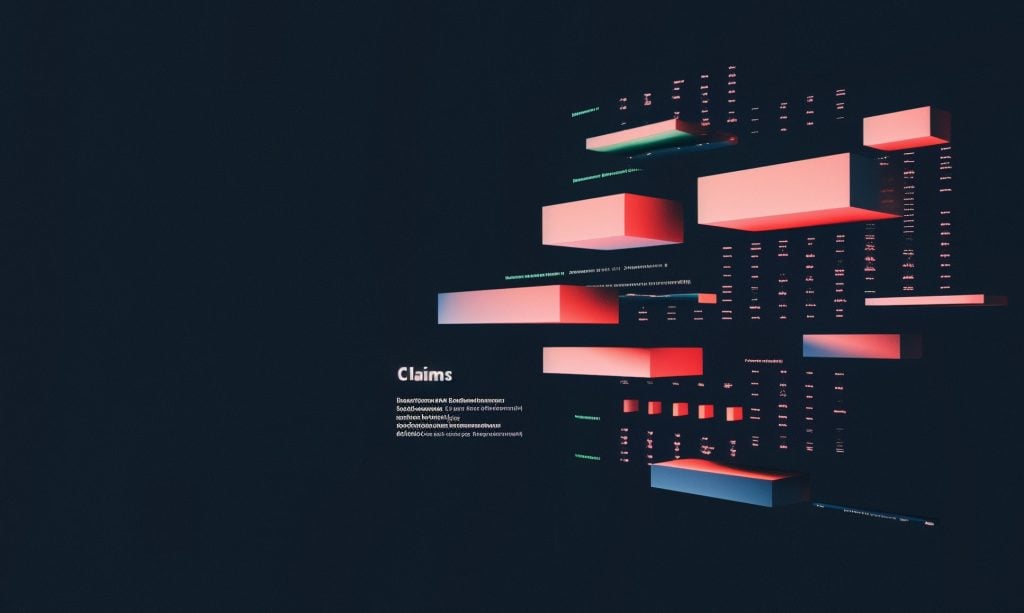You’ve just received a patent document—maybe a competitor’s filing that could block your product launch or prior art that threatens your own application. You open it and face 30+ pages of dense technical jargon, legal terminology, and numbered paragraphs that seem to follow no logical order. Where do you even start? What actually matters?
A patent application is composed of all the elements—such as sections, drawings, specifications, and claims—that collectively define its scope and content. Understanding how these elements fit together is essential for interpreting the document effectively.
This confusion costs businesses millions annually. Patent examiners spend an average of 40% of their examination time just searching through prior art, while companies routinely miss critical patent intelligence because their teams can’t efficiently parse patent documents. Meanwhile, much of the technical information disclosed in patents is never published elsewhere, meaning this confusion literally blocks access to the world’s most extensive technical knowledge base.
Here’s what you’ll discover: a systematic approach to reading any patent document in under 20 minutes, understanding precisely which sections determine legal rights (hint: it’s not what most people think), and extracting the technical insights that can drive your next innovation. By the end, you’ll navigate patent documents like the professionals who draft them for a living.
What is the structure of a patent?
Every year, the United States Patent and Trademark Office (USPTO) receives more than 600,000 patent applications. Globally, patent filing activity reached a record 3.46 million applications in 2022—a 1.7% increase over the prior year. Each patent application follows an identical structural framework that serves both legal and practical purposes. This standardized structure applies to every patent application submitted to the patent office. Only after examination and approval by the office does the application become a granted patent or issued patent, providing enforceable rights to the patent applicant.
This standardization isn’t arbitrary. It emerged from decades of legal evolution designed to solve three critical problems:
For Patent Examiners: As of 2023, the USPTO employed approximately 9,000 patent examiners, each of whom handles hundreds of applications annually. A consistent structure allows any examiner to quickly locate claims, prior art, and technical details across vastly different technologies—from quantum computing to biotechnology.
For Legal Certainty: Patents grant monopoly rights collectively worth billions of dollars. Without standardized sections defining exactly what’s protected, the patent system would collapse into endless litigation over ambiguous boundaries.
For Public Knowledge: Patents represent humanity’s largest technical knowledge repository, with an estimated 17.3 million patents in force worldwide as of 2022. The standardized format makes this knowledge searchable and comparable across technologies and decades.
The structure transforms chaotic technical descriptions into organized, legally enforceable documents. In the U.S., this format is governed by Title 35 of the U.S. Code and Title 37 of the Code of Federal Regulations, as interpreted through the Manual of Patent Examining Procedure (MPEP). Internationally, the Patent Cooperation Treaty (PCT) requires the same core elements—description, claims, abstract, and drawings—creating global consistency.
Essential Components of a Patent Document
Patent documents contain six core sections mandated by law, each serving distinct legal and technical purposes. Both utility and design patent applications, as well as provisional applications, must include these core elements; however, the specific requirements and level of detail may vary for each type of application.
1. Title and Abstract
Provide immediate identification and searchable summaries limited to specific word counts.
2. Front Page Bibliographic Information
Contains patent numbers, dates, inventor/assignee data, and classification codes that establish legal identity.
3. Drawings and Figures
Visual representations that follow strict formatting rules, with reference numerals linking to corresponding text descriptions.
4. Detailed Description (Specification)
This section provides a comprehensive overview of the inventive concept, serving as a description of the invention.
Comprehensive technical explanation enabling others to reproduce the invention—the “teaching” component of the patent bargain.
5. Claims Section
Legal definitions of exclusive rights—literally the only section that determines what’s protected.
The claims section of a patent application contains the types of claims, also known as invention claims, which define the scope of legal protection granted by the patent. Each patent claim serves as a specific legal statement delineating the boundaries of the patented invention. This section is critical because it establishes exactly what is protected, what constitutes infringement, and the extent of the monopoly granted to the patent holder.
6. References and Citations
Prior art considered during the examination shows the technological landscape around the invention.
The references and citations section of a patent lists the prior art cited by the examiner during the patent examination process. Understanding these components is crucial because each section has strict formatting requirements. Claims must be presented on separate pages and expressed in single sentences. Abstracts are limited to 150 words maximum. Patent drawings must adhere to specific line thickness and margin rules as outlined in 37 CFR 1.84. This uniformity enables both human examination and automated systems—modern patent offices use AI-driven tools that recognize patent sections to suggest relevant prior art.
Front Page and Bibliographic Information
The front page serves as the patent’s legal dashboard, packed with data that determines enforceability and commercial value:
Patent Number and Publication Date appear prominently at the top as unique identifiers. For U.S. utility patents filed since June 1995, the term lasts 20 years from the date of the earliest effective filing. Knowing these dates allows you to calculate the expiration and assess whether the patent remains enforceable.
Inventor(s) and Assignee(s) reveal both conception and ownership. The inventors are the individuals who conceived the invention; the assignee is the current owner of the rights associated with it. This distinction matters enormously—if the assignee is a major corporation, expect aggressive enforcement. If it’s a university, there may be government rights attached under the Bayh-Dole Act.
Classification Codes categorize the technology field using the International Patent Classification (IPC) and Cooperative Patent Classification (CPC) systems. The CPC system, jointly maintained by the USPTO and the European Patent Office, contains approximately 250,000 finely delineated categories to route applications to the appropriate expert examiners. These codes are invaluable for finding related patents—a solar cell patent might have IPC “H01L 51/42” (semiconductor devices) and much more granular CPC codes.
References Cited lists prior art considered during the examination, including earlier patents and non-patent literature. Studies show an upward trend in the number of references cited in U.S. patents over time as the body of prior art grows. These citations serve as a roadmap to the state of the art—if you’re evaluating the patent, these references indicate what the examiner considered relevant.
Priority Data establishes the effective filing date for novelty determination. This becomes critical in first-inventor-to-file systems globally. Priority dates may reference earlier related applications (continuations, PCT national phase entries) that establish even earlier effective dates.
For additional patent data, legal status information, and details about the costs associated with obtaining a patent not found on the front page, the USPTO’s Patent Center is a valuable resource.
Title and Abstract: Your Gateway to Patent Intelligence
The Title must be concise and technically accurate, typically under 500 characters, according to USPTO requirements. Effective titles balance specificity with breadth—”Method and Apparatus for Digital Signal Processing” indicate the general field without unnecessarily limiting scope. Examiners may object to overly fanciful titles, requiring more descriptive alternatives.
The Abstract provides a critical 50 to 150-word summary that serves multiple functions. As stated in USPTO rules, it must “enable the USPTO and the public to determine the nature of the technical disclosures quickly.” But its real power lies in searchability—titles and abstracts are primary search fields in patent databases worldwide.
Patent professionals carefully craft these sections with keywords practitioners might use. For a machine learning invention, you’d want “image recognition,” “neural network,” and “artificial intelligence” in the abstract so search queries hit your document. However, the abstract carries no legal weight in defining patent scope—courts typically don’t rely on abstracts for claim interpretation.
The abstract appears on the front page and in international publications under the PCT, making it your invention’s first impression globally. A well-written abstract can prevent confusion and ensure the patent is found by those who need to know about it, whether they’re competitors, potential licensees, or researchers building on your work.
Drawings and Figures: Visual Precision Under Strict Rules
Most patent applications contain drawings, and for good reason—complex inventions often can’t be understood without visual representation. The USPTO maintains exacting standards for patent drawings to ensure clarity and reproducibility.
Format Requirements are non-negotiable: black-and-white line drawings with specific margins (2.5 cm top and left, 1.5 cm right, 1.0 cm bottom) on A4 or letter-size paper. Lines must be uniformly thick and durable. Color drawings require special petitions under 37 CFR 1.84(a)(2) with additional fees, explaining why color is necessary—typically only permitted for design patents or biochemical inventions where color conveys essential information.
Reference Numerals create the crucial link between visual and textual descriptions. Each element receives a number (often 10, 20, or 30 for main components), used consistently throughout the detailed description. A coffee machine patent might show a housing (10), a water reservoir (12), and a heating element (14), allowing the text to reference a “heating element (14) positioned below water reservoir (12).”
Multiple Views and Embodiments fully illustrate complex inventions. Common figure types include perspective views, exploded views showing separated components, sectional views revealing interior details, flowcharts for processes, circuit diagrams, and performance graphs. If an invention has multiple embodiments, drawings may show key variants—a folding chair patent, for example, might include figures for both metal and plastic hinge implementations.
The quality of drawings has a significant impact on the speed of examination. Examiners rely heavily on figures to understand how inventions work, and well-crafted drawings can significantly accelerate the prosecution process. Conversely, unclear or missing drawings can trigger objections and potential rejection due to insufficient disclosure.
Detailed Description and Specification: The Technical Heart
The detailed description represents the patent’s core technical disclosure—the “teaching” side of the patent bargain. In a patented invention, this detailed description serves as the public disclosure required by patent law, enabling others to learn from and build upon the invention. This section must satisfy two fundamental legal requirements that determine patent validity:
Structure and Content
Field of the Invention typically opens with a one-line categorization: “The present invention relates to automotive safety systems, particularly to improved airbag deployment sensors.”
Background (Prior Art) Section describes existing technology and identifies problems the invention solves. This section requires careful drafting—characterizing something as prior art creates admissions that can limit the scope of the claim. Patent drafters avoid statements like “all prior methods are useless,” instead saying, “existing methods have certain limitations (e.g., slow response time), and improvements are desired.”
Summary of the Invention provides an overview of the solution, often mirroring independent claim language in a more descriptive form. This bridges the gap between problem identification and detailed technical implementation.
Brief Description of Drawings lists each figure with one-line descriptions, creating a roadmap to the visual elements.
Detailed Description of Embodiments forms the specification’s core, explaining how to construct and operate the invention with sufficient detail for reproduction by a person of ordinary skill in the art (PHOSITA).
Critical Legal Requirements
Enablement requires that the specification instruct others on how to make and use the invention without undue experimentation. This standard varies dramatically by field—a simple mechanical device may require minimal description, while biotechnology or AI algorithms necessitate extensive detail.
The 2023 Supreme Court decision in Amgen Inc. v. Sanofi dramatically tightened enablement requirements for broad “genus” claims. The Court struck down biotech patent claims covering entire classes of antibodies based on only a few examples, describing the disclosure as “little more than a research assignment.” Following this ruling, the USPTO issued guidelines confirming that examiners should evaluate whether the full claim scope is reasonable to make and use without undue experimentation.
Written Description requires demonstrating that the inventor possessed the claimed invention at the time of filing. This prevents claiming more than what is actually invented and ensures correspondence between claims and inventive contributions. For biotechnology, this issue arose in cases like University of California v. Eli Lilly, where claiming broad genetic sequences requires more than a single example.
Best Mode traditionally required disclosing the inventor’s preferred implementation. While the America Invents Act of 2011 removed the best mode as a ground for invalidation, failure to disclose the best mode remains problematic, especially in other jurisdictions.
Strategic Considerations
Modern patent drafting includes multiple embodiments and alternatives to prevent design-around and support broader claims. For example: “While the embodiment of Fig. 1 uses a spring (106), other implementations could use magnets or elastomers to bias the mass (104).” This supports potential broader claims while showing the invention’s full scope.
Explicit definitions prevent claim construction ambiguity. During litigation, the specification serves as the primary dictionary for claim terms. Clear definitions, such as “As used herein, ‘network node’ refers to any device capable of transmitting or receiving data, including sensors, routers, and user devices,” can prevent unfavorable interpretations.
Patent Claims: Where Legal Rights Are Born
If the specification is the patent’s heart, the claims are its soul. As famously stated by Chief Judge Giles Rich of the Federal Circuit: “The name of the game is the claim.” Claims define the exact legal boundaries of protection—what the patentee can prevent others from making, using, or selling. In infringement cases, courts determine whether an accused product or process practices every element of the patented claims.
Claim Structure and Format
Claims begin on a separate page and are numbered consecutively, with each claim forming a single sentence (leading to remarkably complex sentences). The format typically follows: “A [category] comprising: [Element A]; [Element B]; and [Element C].”
Independent Claims stand alone, defining complete inventions without referencing other claims. These represent the broadest protection for each aspect of the invention.
Dependent Claims reference earlier claims and add limitations, creating narrower fallback positions. For example:
- Claim 1 (independent): “An electronic device comprising a processor and memory storing instructions…”
- Claim 2 (dependent): “The device of claim 1, further comprising a wireless transceiver.”
- Claim 3 (dependent): “The device of claim 1 or 2, wherein the memory comprises flash memory.”
This structure provides strategic advantages: if Claim 1 faces invalidity due to prior art, Claim 2 might survive because of the additional transceiver element. The USPTO charges extra fees for more than 20 total claims or more than three independent claims, encouraging strategic claiming.
Transitional Phrases: Small Words, Huge Impact
The transitional phrase following a claim’s preamble dramatically affects scope:
“Comprising” creates open-ended claims—the invention includes listed elements but doesn’t exclude others. If Claim 1 recites “comprising A, B, and C,” a device with A, B, C, and D still infringes. This open-ended interpretation makes “comprising” the most popular transitional phrase because additional elements don’t avoid infringement.
“Consisting of” creates closed claims limited to listed elements only. A composition “consisting of A, B, and C” excludes devices with the additional element D. This provides narrower protection but greater specificity, often used in chemical compositions where precise formulation matters.
“Consisting essentially of” falls between open and closed, allowing elements that don’t materially affect the invention’s basic characteristics while excluding significant additions that would substantially change properties.
Multiple Claim Sets and Strategic Coverage
Patents often include multiple independent claims covering different aspects:
- Apparatus claims protect the physical device
- Method claims protect the process of using the device
- System claims protect networked implementations
- Computer-readable medium claims protect software embodiments
This multi-faceted approach covers various infringement scenarios. A competitor might avoid the apparatus claim by using different hardware but still infringe the method claim by performing the same process.
Claim Scope: The Balancing Act
Broad claims provide stronger protection against design-arounds but face greater invalidity risks if they’re too broad relative to prior art.
Narrow claims with many limitations are easier to defend but offer limited competitive moats.
Patent drafters constantly balance these competing pressures, often starting with broad claims and adding dependent claims with increasing specificity. During prosecution, if broad claims face rejection, narrower dependent claims may be rewritten as independent claims and allowed.
Claim Construction and Interpretation: Where Millions Are Won and Lost
How claims are interpreted often determines the outcome of patent litigation. Courts follow the Phillips v. AWH standard, interpreting claims based on intrinsic evidence (the patent itself and prosecution history) before considering extrinsic evidence (expert testimony, technical dictionaries).
The Interpretation Hierarchy
Plain Meaning governs unless the specification provides special definitions. Terms receive their ordinary meaning to a person skilled in the art at the time of invention.
Specification as Dictionary allows inventors to act as their own lexicographers, defining terms specifically for their patent. For example, if the spec states, “as used herein, ‘flexible’ means capable of bending with a radius of curvature less than 5 cm,” that definition controls over ordinary meaning.
Prosecution History can limit the scope of a claim through prosecution history estoppel. If an applicant narrows claims to overcome prior art, they typically can’t recapture surrendered scope through the doctrine of equivalents.
Examination vs. Litigation Standards
During the USPTO examination, claims receive the “broadest reasonable interpretation” consistent with the specification. This broader reading encourages applicants to clarify ambiguous terms during prosecution when they can still amend claims.
After patent issuance, courts apply the Phillips standard, often interpreting it more narrowly in light of the specification’s context and prosecution history. This difference affects prosecution strategy—applicants should assume the broadest reasonable meaning and clarify terms that might be misinterpreted.
Prosecution History and Amendments: The Patent’s Evolution
Every patent has a backstory captured in its prosecution history (file wrapper)—the complete record of communications between the applicant and examiner. This history often proves crucial during litigation for understanding the scope and validity of claims.
Prosecution history is also frequently examined during a patent trial to determine the validity and enforceability of the patent.
Office Actions and Responses
Office Actions detail examiner rejections based on prior art, disclosure deficiencies, or claim indefiniteness. For example: “Claims 1-5 are rejected under 35 U.S.C. 102 as anticipated by Smith et al. (US Patent No. 9,123,456)” or “Claim 1 is rejected under 35 U.S.C. 103 as obvious over the combination of Jones et al. and Lee et al.”
Applicant Responses address rejections through claim amendments, arguments, or both. Responses typically explain: “Smith did not disclose a widget with the flexible hinge as now required by claim 1; this feature provides XYZ advantage and is not taught by any cited reference.”
Amendment Consequences
Claim amendments during prosecution can trigger prosecution history estoppel, preventing patent owners from later recapturing surrendered scope through the doctrine of equivalents. If claims originally covered “metal fasteners” but were narrowed to “steel fasteners” to avoid prior art, the patent owner typically can’t later argue that aluminum fasteners infringe under equivalents.
Interview Summaries document examiner-applicant discussions, often revealing examination concerns and potential amendment strategies. These informal communications can provide valuable insight into claim interpretation.
Allowance Notices explain why final claims are patentable, sometimes including “Reasons for Allowance” that highlight distinguishing features. While not binding, these explanations can influence later claim construction.
Continuation Practice and Patent Families
Many patents involve complex prosecution strategies with multiple related applications:
- Continuations pursue different claims from the same disclosure.
- Divisionals separate related inventions that are split during the examination.
- Continuation-in-part applications add new matter to pending applications.
The front page documents these relationships, and the prosecution history can span multiple applications in a family. Arguments made in one application may influence the interpretation of claims in related patents, primarily when identical disclosure supports the claims.
Which Part of the Patent Document Defines the Rights?
The claims—and only the claims—define patent rights. This principle represents the fundamental bedrock of patent law, established through centuries of legal evolution. The claims set the scope of patent protection, determining the legal monopoly granted to the patent holder. The extent of these rights is limited by the patent’s term, which is determined by law and may be subject to extensions or adjustments, thereby affecting the duration of the patent protection.
While other sections serve critical functions, only claims create enforceable exclusivity:
Non-claim sections (title, abstract, background, drawings) aid understanding and search but don’t confer rights. You cannot infringe a patent by doing something only described in the background or shown in drawings—infringement requires practicing claimed elements.
Specification’s Role supports and interprets claims but doesn’t itself create protection. The detailed description might describe ten embodiments, but if claims only cover five, the remaining embodiments are effectively dedicated to the public.
The Property Line Analogy
Think of a patent like real estate: the specification resembles a detailed landscape survey with descriptions of trees, rivers, and structures. However, the claims are the surveyor’s property lines—the legal boundaries that determine ownership. Activities within those boundaries may infringe; activities outside are free.
Everything Unclaimed Is Free
This principle creates strategic implications: inventors must carefully consider what to claim versus what to merely describe. Anything disclosed but unclaimed becomes prior art against later patents while providing no protection to the original inventor. Unclaimed embodiments may also serve as prior art for similar inventions filed by others in the future.
For example, suppose a specification discloses using parameter values from 1 to 100 but claims to cover only values from 1 to 50. In that case, competitors can freely use 75 without literal infringement (and likely without equivalent infringement if the limitation was deliberate).
How to Read a Patent: A Professional’s Systematic Approach
Reading patents efficiently requires prioritizing sections by importance and following a structured methodology that professionals use to parse documents quickly:
Phase 1: Initial Assessment (2-3 minutes)
- Scan the title and abstract for subject matter relevance.
- Check the publication or issue date for timeline context.
- Note inventor/assignee for competitive intelligence.
- Review classification codes for technology categorization.
Phase 2: Visual Understanding (3-5 minutes)
- Examine all drawings before reading the detailed text.
- Read a brief description of the figures for orientation.
- Identify main reference numerals (typically 10, 20, and 30 for major components).
- Map visual elements to understand physical/logical structure.
Phase 3: Context and Problem Definition (2-3 minutes)
- Skim the background section for prior art context.
- Read the summary for the proposed solution overview.
- Identify the core problem the invention addresses.
Phase 4: Legal Scope Analysis (5-7 minutes)
- Read ALL independent claims first (usually Claims 1, 10, 20, etc.).
- Break each independent claim into elements (often separated by semicolons).
- Map claim elements to drawings using reference numerals.
- Review key dependent claims for significant limitations.
- Note transitional phrases (“comprising” vs. “consisting of”).
Phase 5: Technical Deep Dive (5-8 minutes)
- Read detailed descriptions selectively, focusing on sections that explain the claimed elements.
- Look for explicit definitions of claim terms.
- Note examples and experimental results if present.
- Identify variations and alternatives described but not necessarily claimed.
Reading Strategy by Purpose
For Infringement Analysis: Compare each claim element against your product/process feature-by-feature. Missing even one element typically avoids literal infringement.
For Validity Research: Identify claim elements and search for prior art showing those combinations. Note any admissions in the background section.
For Technical Intelligence: Focus on providing detailed descriptions and examples that highlight implementation details and technical insights often unavailable elsewhere.
For Competitive Analysis: Examine prosecution history through the patent’s file wrapper to understand how claims evolved and what arguments were made.
Legal Notices and Disclaimers: Understanding Patent Lifetime
Patent documents include several notices affecting enforceability and commercial value. Only patented inventions—those for which the government has granted a patent—are subject to the legal notices and requirements described in this section.
Patent Term and Maintenance
Utility Patent Term lasts 20 years from the earliest non-provisional filing date, but several factors can modify this:
- Patent Term Adjustment (PTA) compensates for delays by the USPTO during examination.
- Patent Term Extension (PTE) under 35 USC §156 compensates for FDA regulatory delays (pharmaceuticals/medical devices only).
- Terminal Disclaimers may shorten the term to match related patents.
Maintenance fees are required at 3.5, 7.5, and 11.5 years after the grant to maintain U.S. patents. Only about 50% of U.S. patents are kept for the full 20-year term; many are allowed to lapse when the fees exceed the perceived value.
Special Notices
Government Interest Statements appear when inventions received federal funding under the Bayh-Dole Act: “This invention was made with government support under [grant number]. The government has certain rights in the invention.” This grants the government nonexclusive license rights.
Terminal Disclaimers resolve double-patenting rejections by linking patent terms: “Subject to any disclaimer, the term of this patent is disclaimed beyond [date].” These disclaimers are heavily used in pharmaceutical patent portfolios to create patent thickets while avoiding indefinite term extension.
Priority Claims reference earlier applications (domestic, foreign, or PCT) establishing effective filing dates for prior art purposes. These relationships can significantly affect validity and enforcement strategies.
Status Verification
Modern patent databases typically display the current status as “Active – expires 2035” or “Expired – Fee-Related.” However, official patent documents may not indicate expiration unless disclaimers occurred during prosecution.
For business decisions, always verify current status through official USPTO records or professional patent status services, as maintenance fee payments can occur after apparent lapse dates through petition processes.
Conclusion: Mastering Patent Architecture for Competitive Advantage
Understanding patent structure transforms how you engage with the innovation economy. You now possess the framework used by professionals who draft, prosecute, and enforce patents collectively worth billions of dollars.
The Strategic Advantage: While competitors struggle to parse patent documents, you can quickly identify what’s protected (claims), how it works (specification), and when protection expires (legal notices). This intelligence advantage drives better R&D decisions, more effective freedom-to-operate analysis, and stronger IP portfolios.
The Knowledge Arbitrage: With much of the technical information disclosed in patents never published elsewhere, your ability to efficiently extract technical insights from patent literature provides access to humanity’s most extensive technical knowledge base—a competitive advantage most organizations fail to exploit.
Global Consistency: The Patent Cooperation Treaty (PCT) has standardized application formats across over 150 countries, making your patent reading skills transferable worldwide. Whether analyzing U.S. patents, European applications, or Chinese filings, the core structural principles remain constant.
Your Next Steps
- Practice with Real Patents: Find patents in your technology area and apply this systematic reading approach.
- Develop Keyword Libraries: Build search terms based on classification codes and technical terminology from key patents.
- Monitor Competitive Intelligence: Set up patent alerts for key assignees and technology classifications in your field.
- Train Your Team: Share this framework with colleagues to create organizational patent literacy.
The patent system will continue evolving with new technologies and international harmonization efforts, but the fundamental structural principles remain constant. Patents will continue to serve as critical tools for protecting innovation, sharing technical knowledge, and establishing exclusive rights that drive technological advancements.
Master this structure, and you master one of the most powerful information systems in the global economy—one that reveals not just what competitors are doing but where entire industries are heading.




